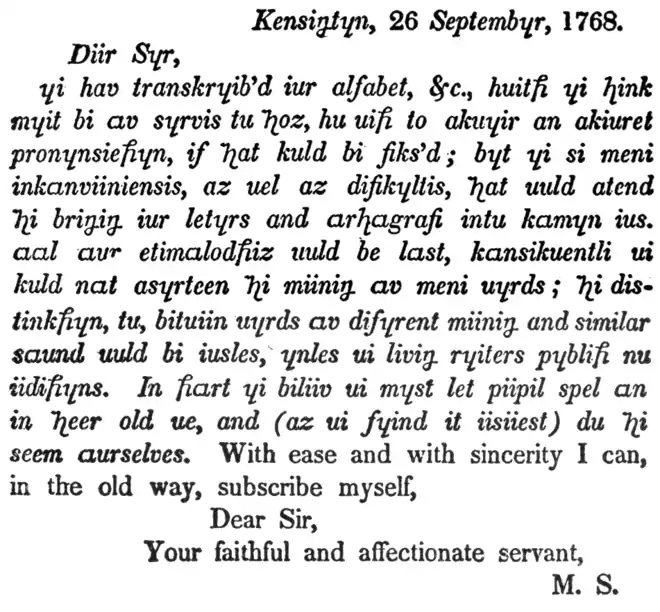Alphabet de Franklin
L’alphabet de Franklin a été proposé par Benjamin Franklin comme réforme de l’orthographe de la langue anglaise dans A Scheme for a New Alphabet and Reformed Mode of Spelling publié en 1768. Cet alphabet de 26 lettres est basé sur l’alphabet anglais et l’alphabet latin, omettant les lettres ‹ c, j, q, w, x, y › et ajoutant des lettres inventées pour remplacer les digrammes ‹ sh, ng, th › ou pour distinguer certaines voyelles, représentant chaque son par un seul symbole.

Lettre à Franklin retranscrite avec l’alphabet de Franklin publiée dans The Writings of Benjamin Franklin, 1906, volume 3.
Bibliographie
- Benjamin Franklin's Phonetic Alphabet, Omniglot.com
- (en) Benjamin Franklin, « A reformed mode of spelling », dans Political, miscellaneous, and philosophical pieces, London, J. Johnson, , 467-478 p. (lire en ligne)
- (en) Benjamin Franklin et Albert Henry Smyth, « A Scheme for a new alphabet », dans The writings of Benjamin Franklin, vol. 5, New York, The MacMillan Company, , 169‒177 (lire en ligne)
- (en) Kemp Malone, « Benjamin Franklin on Spelling Reform », American Speech, vol. 1, no 2, , p. 96–100 (DOI 10.2307/452554)
- (en) Sal Robinson, « Benjamin Franklin’s phonetic alphabet and the development of American English »,
- (en) Jimmy Stamp, « Benjamin Franklin’s Phonetic Alphabet », Smithsonian Magazine, (lire en ligne)
- (en) Nicola Twilley, Six new letters for a aeformed alphabet, (lire en ligne)
- Portail de l’écriture
- Portail de la linguistique
Cet article est issu de Wikipedia. Le texte est sous licence Creative Commons - Attribution - Partage dans les Mêmes. Des conditions supplémentaires peuvent s'appliquer aux fichiers multimédias.